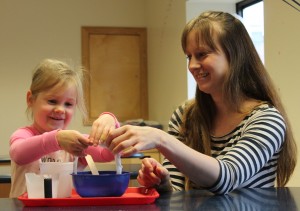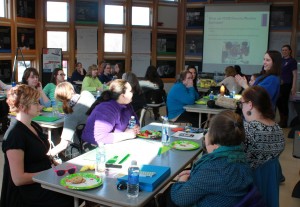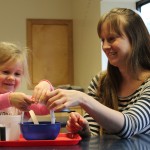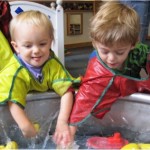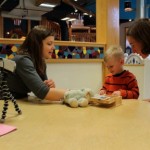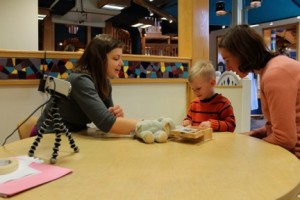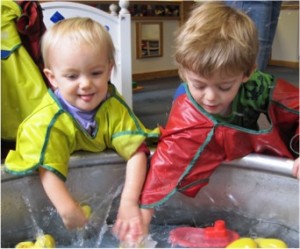
Visitors at the Sciencenter splash around in a Curiosity Corner exhibit-an area specially designed for children 4 years and younger. This will be one of the water exhibits featuring the new signage. Photo by Sciencenter.
How and when we learn is not determined by a class schedule. With most of our lives spent outside of a classroom, more attention should be paid to the learning that takes place in the “real world.”
Kelly Yang, a senior majoring in human development and minoring in biological sciences at Cornell University, is doing just that. Kelly has been a research assistant in Cornell’s Early Childhood Cognition Lab (ECC Lab), directed by Dr. Tamar Kushnir, since her freshman year.
ECC Lab researchers design toys, games, and stories to study how children learn. These tools are implemented in the lab, at local schools, and at informal science education institutions like the Sciencenter.
Cornell’s ECC Lab and the Sciencenter are partnering to research early childhood development and how caregivers interact with children during the learning process. The partnership aims to ultimately create and provide caregivers with the tools needed to maximize their child’s learning.
The partnership’s SENCER-ISE-funded research began with Dr. Kushnir’s Spring 2014 Concepts and Theories in Childhood course, in which, students worked with Sciencenter director of education, Michelle Kortenaar, and museum staff to conduct research on how children interact with caregivers and museum exhibits.
The Concepts and Theories course stood out among Kelly’s other courses because it provided her with the opportunity to actually apply her knowledge and course work in the field. Kelly says she “thinks it’s great for undergraduates; especially juniors and seniors, to get a feel for how their academic backgrounds will come into play in their future jobs and careers.”
Recently, Kelly took the time to reflect on her work the the ECC Lab and the Sciencenter:
A 5-year-old boy stands next to me and together we gaze at some red and white, Frisbee- and spherically-shaped objects. We are at the Sciencenter, looking at an exhibit about blood. I ask, “What is that stuff?”
With his five-year-old lisp, he responds matter-of-factly,“They’re red and white blood cells.”
“What do they do?”
“The white blood cells, they protect your body. And the red ones, they carry oxygen.”
“Oh cool…what else is in the blood?”
“T Cells and B Cells. They fight the bad guys. Like ninjas!”
—
As a research assistant in Cornell’s Early Childhood Cognition Lab, I am repeatedly amazed how well-equipped we are to learn from a young age. The five-year-old boy in the anecdote above knew middle school-level biology simply from being around his dad, who is a scientist at Cornell. In the Lab, we examine children’s learning and thinking using activities and games specifically designed for a controlled lab setting. This summer, I worked at the Sciencenter, a hands-on museum in Ithaca, NY to develop a new project for the Lab. This project examines children’s learning in the organic and messy real world to see how they learn in informal learning environments.
It is understood in the field of developmental psychology that children use concepts and categories to make sense of the world around them. If an adult presents a child with a blue sphere and a red sphere and labels both with the word “ball”, a child can infer that “ball” refers to a category of objects that are round. To apply this idea in the real world, we are connecting several museum exhibits that share the concept of “water”.
Mariel Schneider, an Early Childhood Cognition Lab alumnus, began working on this project last summer. She focused on using signage to bring attention to the concept of water. This year, Dr. Tamar Kushnir’s class on Concepts and Theories in Childhood brainstormed to further Mariel’s work. As part of the class, students observed caregiver-child interactions at various exhibits that all shared the theme of water. The class collectively decided that the project was in need of an interactive component. Our idea was to use a scavenger hunt to highlight the water concept, and my goal for the summer was to create it.
While at the Sciencenter, I prototyped a number of activities and steps on the museum floor. I ultimately found that children enjoy doing crafts and having something to take home. I created pocket-sized booklets for children to use in the scavenger hunt and take home afterwards. I also designed custom stampers to use for the scavenger hunt throughout the museum. In addition to working on the Lab’s project, I helped the Sciencenter’s education team run and assess early childhood programming, looking for ways to engage parents and caregivers in their children’s science learning. I also had the opportunity to lead a professional development workshop for Sciencenter staff and share my knowledge of current research in early childhood cognitive development.
This summer, the amount of creative freedom that the project allowed me helped me to grow in my learning and thinking. It was challenging and immensely rewarding to apply my knowledge outside of the classroom. My experiences at the Sciencenter are invaluable to my future career as a pediatrician because not only am I prepared to work with children and their parents, but also prepared to discuss relevant issues in the workplace.
Moving forward, I along with a team of other research assistants will be collecting data on the scavenger hunt game throughout the following semester. We hope to learn more about caregiver-child interactions and gain insight into concept formation in a museum setting. My summer at the Sciencenter was pivotal in laying the groundwork for this project and I am eager to see how the rest unfolds.
Through her research, Kelly has also observed the advantages of informal science education. Kelly had always appreciated informal science education institutions and environments, but she now has a “much deeper appreciation of all the careful thought and planning that goes into creating museum programs and exhibits.” She remarks that she’s always been “interested in education, but now informal education is even more appealing since there is so much room for creativity.”
